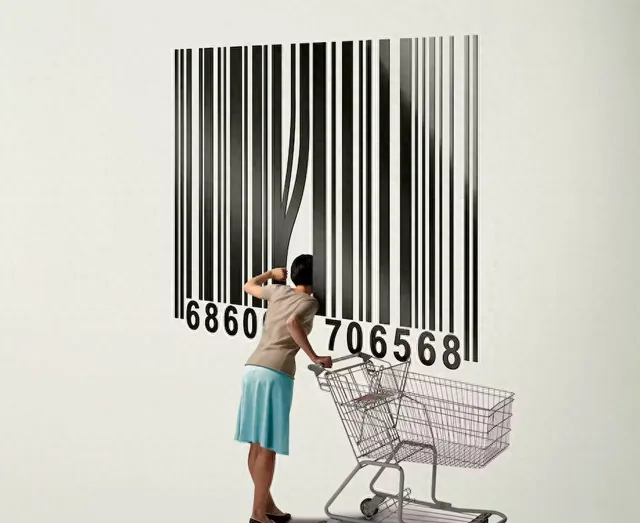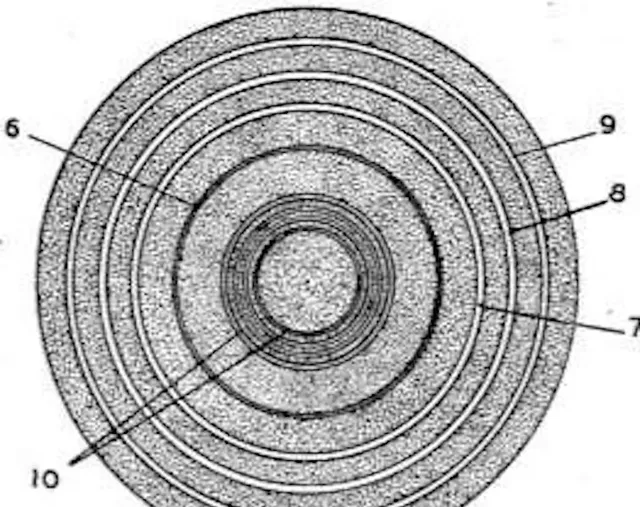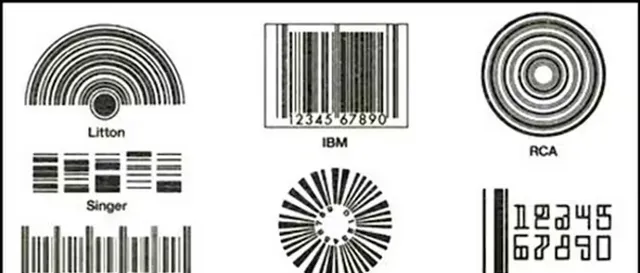
Few objects in the world are more immediately recognizable than the bar code. After all, bar codes are all around us. They're on the books we buy and the packages that land on our doorsteps. More than 6 billion bar codes are scanned every single day. They've become such an accepted part of our daily lives that it's hard to imagine how they could look any different.
世界上很少有比条形码更容易识别的物品了。毕竟,条形码就在我们身边。我们买的书上有,我们家门口的包裹上也有。每天扫描的条形码超过 60 亿个。条形码已经成为我们日常生活的一部分,很难想象它们会有什么不同。
I've researched various technologies throughout my career as a media studies professor, but it wasn't until I began writing my book about the cultural history of the bar code that I realized how even the most mundane objects in our lives look the way they do because of decisions that are mostly lost to history. When I began combing through the archive of bar code history at Stony Brook University, I realized just how close we came to a world where we scan bull's-eye or Sun symbols to buy our groceries.
作为一名媒体研究教授,我在整个职业生涯中都在研究各种技术,但直到我开始撰写关于条形码文化史的书时,我才意识到,即使是我们生活中最普通的物品,它们之所以会变成现在这个样子,也是由于那些大多已被历史遗忘的决定。当我开始梳理石溪大学的条形码历史档案时,我意识到我们离扫描牛眼或太阳符号来购买杂货的世界有多近。
Our story begins in 1949, when Joseph Woodland and Bernard Silver submitted a patent for the first bar code. That patent described the basic structure of using pairs of lines to represent numbers that is still used in bar code technology more than 70 years later.
我们的故事始于 1949 年,当时约瑟夫-伍德兰和伯纳德-西尔弗提交了第一份条形码专利。该专利描述了使用成对的线条表示数字的基本结构,70 多年后的今天,条形码技术仍在使用这种结构。

What their patent didn't include, however, was anything most people today would recognize as a bar code. In fact, the first bar code didn't include vertical lines at all. Instead, the world's first bar code used a series of concentric circles in the shape of a bull's-eye.
然而,他们的专利并不包括任何今天大多数人都能识别的条形码。事实上,第一个条形码根本不包括垂直线。相反,世界上第一个条形码使用了一系列牛眼形状的同心圆。

Woodland and Silver initially struggled to get companies interested in their invention. But the bar code's fortunes began to change in 1960, when the engineer and physicist Theodore H. Maiman built the first working laser, which made it possible to quickly decode a bar code's line patterning.
伍德兰和西尔弗起初很难让公司对他们的发明感兴趣。但条形码的命运在 1960 年开始发生变化,工程师兼物理学家西奥多-H-迈曼制造出了第一台工作激光器,从而可以快速解码条形码的线条图案。
Not long afterward, in 1967, the railroad industry implemented Kartrak, which was the world's first official bar code system. Kartrak bar codes were developed to automatically identify rail cars as they moved past scanners, but they used a design of lines of varying colors that looks more like a piece of modern art than the bar codes we use today.
不久之后的 1967 年,铁路行业开始使用 Kartrak,这是世界上第一个正式的条形码系统。Kartrak 条形码的开发是为了在铁路车辆经过扫描仪时自动识别它们,但它们使用了不同颜色的线条设计,看起来更像是一件现代艺术品,而不是我们今天使用的条形码。
But Kartrak struggled from the start – the system wasn't as accurate as people had hoped – and it stopped being used in the 1970s. Despite being the first bar code to be officially adopted by an industry, the multicolored design of the Kartrak symbol is now just a footnote in history.
但 Kartrak 从一开始就举步维艰--该系统并不像人们希望的那样精确,因此在 20 世纪 70 年代就停止使用了。尽管 Kartrak 是第一个被行业正式采用的条形码,但它的多色符号设计现在只是历史的一个注脚。
Around the same time Kartrak was launched, the grocery industry set in motion a chain of events that eventually resulted in the bar code we know today. In the late 1960s, various stores began bar code pilot projects that used vastly different types of bar code symbols.
大约在 Kartrak 推出的同时,零售业也开始了一连串的活动,最终形成了我们今天所熟知的条形码。20 世纪 60 年代末,各种商店开始了条形码试点项目,使用的条形码符号类型大相径庭。
One of the symbols was the original bull's-eye bar code, which by that point was owned by RCA because it had purchased the patent rights. But other stores used symbols developed by other companies. For example, a company named Carecogn had developed a Sun symbol and the Litton company created a fan symbol that were part of pilot projects. The grocery industry soon realized that this Wild West period of experimentation couldn't last.
其中一个符号是最初的 "牛眼 "条形码,由于 RCA 已购买了专利权,因此该条形码归 RCA 所有。但其他商店使用的是其他公司开发的符号。例如,一家名为 Carecogn 的公司开发了一种太阳符号,而 Litton 公司则创造了一种风扇符号,这些都是试点项目的一部分。零售业很快就意识到,这种狂野的西部试验期不可能持久。
Bar codes could work as a way to automate inventory and checkout only if everyone in the grocery industry agreed to use the same symbol. Otherwise, the system would be overly complex and expensive. So in 1971, the grocery industry formed a committee tasked with developing an industrywide data standard and choosing a symbol that stores would agree to adopt.
只有当零售业的每个人都同意使用相同的符号时,条形码才能作为库存和结账自动化的一种方式发挥作用。否则,系统就会过于复杂和昂贵。因此,1971 年,零售业成立了一个委员会,负责制定全行业的数据标准,并选择一个商店同意采用的符号。
The data standard the committee developed – the Universal Product Code – was designed to work with different types of bar code symbols. It's still in use 50 years later.
该委员会制定的数据标准--通用产品代码--旨在与不同类型的条形码符号配合使用。50 年后,它仍在使用。
The committee then had to choose the symbol. They solicited applications from various companies and narrowed the pool down to seven finalists. That was when the drama really began.
然后,委员会必须选择符号。他们向各家公司征集申请,最后筛选出七家入围公司。戏剧性的一幕就此拉开序幕。

The RCA submission was the early leader among the seven finalists. The bull's-eye bar code, after all, was the original bar code symbol, and RCA was a powerful company that had invested significant resources in developing the technology. RCA's main competitor was a latecomer to the battle for bar code dominance: the IBM symbol invented in the early 1970s by George Laurier.
RCA 提交的方案在七家入围公司中处于领先地位。毕竟,"牛眼 "条形码是最初的条形码符号,而 RCA 是一家实力雄厚的公司,在开发该技术方面投入了大量资源。RCA 的主要竞争对手是条形码争霸战的后来者:乔治-劳里埃在 20 世纪 70 年代初发明的 IBM 符号。
Between March 1971 and March 1973, the committee extensively tested the seven finalists, listened to pitches from each company and met multiple times to discuss the path forward. Throughout the process, RCA and IBM remained the front-runners, and in a somewhat ironic twist, Joseph Woodland – the 「father of the bar code」 and inventor of the bull's-eye symbol – advocated for the IBM symbol over his own invention.
从 1971 年 3 月到 1973 年 3 月,委员会对最终入围的七家公司进行了广泛的测试,听取了每家公司的介绍,并多次开会讨论未来的发展方向。在整个过程中,RCA 和 IBM 始终处于领先地位,而具有讽刺意味的是,"条形码之父"、牛眼符号的发明者约瑟夫-伍德兰(Joseph Woodland)主张采用 IBM 的符号,而不是他自己的发明。
Realizing their symbol might not be selected, RCA began to pressure the committee and threatened to pull out of the bar code industry altogether if their bull's-eye bar code was not chosen as the industry standard.
RCA 意识到自己的符号可能会落选,于是开始向委员会施压,并威胁说如果他们的牛眼条形码不被选为行业标准,他们将彻底退出条形码行业。
The committee's deadline to select a symbol was March 1973, and the decision went down to the wire. In its final meeting, the committee chose the IBM symbol despite concerns that, to quote the historian Stephen Brown, 「by opting for the oversquare symbol instead of the bulls-eye, the Committee may have dramatically slowed the pace of implementation」 because of RCA's pressure.
委员会选择标志的最后期限是 1973 年 3 月,决定是在最后一刻才做出的。在最后一次会议上,委员会选择了 IBM 符号,尽管有人担心,引用历史学家斯蒂芬-布朗的话说,"由于 RCA 的压力,委员会选择了超方形符号而不是牛眼符号,这可能会大大延缓实施的步伐"。
The IBM symbol became the industry standard, and the very first Universal Product Code bar code was scanned at a grocery store in Troy, Ohio, on June 26, 1974. Rather remarkably, the IBM symbol the committee chose is still going strong almost 50 years later. The bar codes you scan at a grocery store are essentially the same bar codes someone would have scanned in the 1970s.
IBM 符号成了行业标准,1974 年 6 月 26 日,俄亥俄州特洛伊市的一家杂货店扫描了第一个通用产品代码条形码。令人惊讶的是,委员会选择的 IBM 符号在将近 50 年后的今天仍在继续使用。您在杂货店扫描的条形码与 20 世纪 70 年代人们扫描的条形码基本相同。
Based on meeting notes from the symbol selection meetings, the committee members felt they were doing important work. But even in their wildest dreams, they could not have imagined how consequential their decision ended up being.
根据符号选择会议的会议记录,委员会成员认为他们所做的工作非常重要。但即使在他们最疯狂的梦想中,他们也无法想象他们的决定最终会产生多大的影响。
The bar code design they selected became one of the most iconic images of capitalism and has inspired architects' building designs, symbolized dystopian conformity in science fiction, become a popular tattoo and even inspired online fan communities.
他们选出的条形码设计成为资本主义最具标志性的形象之一,激发了建筑师的建筑设计灵感,在科幻小说中象征着乌托邦式的顺从,成为一种流行的纹身,甚至激发了网络粉丝社区的灵感。
But the design that changed the world came remarkably close to being a forgotten piece of history. If a few grocery executives had voted a different way, we might be moving through a world filled with bull's-eyes.
但是,这个改变了世界的设计却差一点成为被遗忘的历史。如果当时有几位杂货店高管投了不一样的票,我们可能就会在一个充满牛眼的世界里穿梭。











